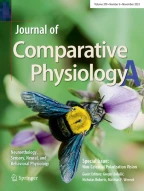Summary
The prey-catching activity of the toadBufo b. bufo was measured in response to various configurational moving two-dimensional black or white stimuli contrasting with various homogeneous or structured backgrounds (Figs. 1 to 5).Area discrimination was tested with squares of different sizes,configurational discrimination with stripes of equal size and different configuration (‘worm’ or ‘antiworm’), andlength discrimination with worm-like stripes of different length.
Signal Extraction. A 2×5 mm2 wormlike stripe of a luminanceL s≈36 cd×m−2, for example, was practically not resolved from a homogeneous background of almost the same luminanceL b = 36. But it could be well detected if the background was structured (\(\bar L_B = 36\)); at a given luminance (\(\bar L_B \approx 36\)) the releasing value of the grey stimulus (L s= 36) increased to some extent with structure width of the background (Fig. 1 c-e).
Configurational Discrimination. The basic stimulus response relationships were maintained, if Configurational stimuli were moved against black, white, grey or structured backgrounds. However, in the range of short stripes (xl= 5 mm) the worm/antiworm discrimination was significantly better withblack stimuli moving against white background than forwhite against black (curvesa andc in Figs. 2A and 3A). The Configurational selectivity in response to white wormlike and antiwormlike stripes increased if stimuli were moved against a grey or a structured background (curvesa andc in Figs. 2 and 3B-E forxl≧5 mm).
Length Discrimination. Relatively short stripes (close to the square configuration) and relatively long ones were discriminated less well than those in a medium size range. The optimal discrimination range was different for black stimuli (range: 3≦xl 1≦6.5 mm) and white stimuli (range: 5≦xl 1≦ 10 mm) (Fig. 4A, B). Discrimination in this range could be enhanced to some extent if the background was structured. These results were consistent for artificially (Fig. 4A) and naturally structured backgrounds (Fig. 5A-C).
The results show that stimulus discrimination in toads depends largely on the values of Configurational parameters. The background structure may have distinct effects on stimulus perception, i.e., either masking or facilitation.
Similar content being viewed by others
References
Autrum H (1959) Das Fehlen unwillkürlicher Augenbewegungen beim Frosch. Naturwissenschaften 46:435
Burghagen H, Ewert J-P (1982) Influence of background structure on perception of non-moving prey dummies by toadsBufo bufo (L.) (submitted)
Cromarty AS, Schürg-Pfeiffer E, Ewert J-P (1982) Influence of Kainic-acid injections into the TP-region on response properties of neurons in the optic tectum inRana temporaria L. (in preparation)
Ewert J-P (1976) The visual system of the toad. Behavioral and physiological studies on a pattern recognition system. In: Fite KV (ed) The amphibian visual system. A multidisciplinary approach. Academic Press, New York San Francisco London
Ewert J-P (1983) Tectal mechanisms underlying prey-catching and avoidance behaviors in toads. In: Vanegas H (ed) Comparative neurology of the optic tectum. Plenum Press, New York
Ewert J-P, Seelen W von (1974) Neurobiologie und System-Theorie eines visuellen Mustererkenuungsmechanismus bei Kröten. Kybernetik 14:167–183
Grüsser O-J, Grüsser-Cornehls U (1976) Neurophysiology of the anuran visual system. In: Llinás R, Precht W (eds) Frog neurobiology. Springer, Berlin Heidelberg New York
Hoffmann KP, Seelen W von (1978) Analysis of neuronal networks in the visual system of the cat using statistical signals; simple and complex cells: Part II. Biol Cybern 31:175–185
Hubel DH, Wiesel TN (1962) Receptive fields, binocular interaction and functional architecture in the cat's visual cortex. J Physiol (Lond) 160:106–154
Hubel DH, Wiesel TN (1965) Receptive fields and functional architecture in two nonstriate visual areas (18 and 19) of the cat. J Neurophysiol 28:229–289
Julesz B (1976) Experiments in the visual perception of texture. In: Held R, Richards W (eds) Recent progress in perception. Readings from Scientific American. Freeman, San Francisco
Kuffler SW (1953) Discharge patterns and functional organization of the mammalian retina. J Neurophysiol 16:37–68
Schürg-Pfeiffer E, Ewert J-P (1981) Investigation of neurons involved in the analysis of Gestalt prey features in the frogRana temporaria. J Comp Physiol 141:139–152
Seelen W von, Hoffmann KP (1976) Analysis of neuronal networks in the visual system of the cat using statistical signals: Part I. Biol Cybern 22:7–20
Author information
Authors and Affiliations
Rights and permissions
About this article
Cite this article
Ewert, J.P., Burghagen, H., Albrecht, L. et al. Effects of background structure on the discrimination of configurational moving prey dummies by toadsBufo bufo (L.). J. Comp. Physiol. 147, 179–187 (1982). https://doi.org/10.1007/BF00609842
Accepted:
Issue Date:
DOI: https://doi.org/10.1007/BF00609842
